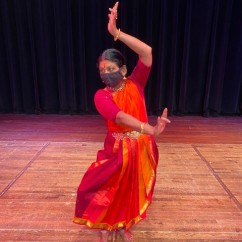In normal times, Natya Dance Theatre (NDT) performs multiple times a year in various theaters in the Chicagoland area and teaches hundreds of students the art of bharatanatyam— in person—from studios in Chicago, Naperville and Downers Grove. These are not normal times. How does one of the most “critically acclaimed Indian dance companies in the United States” deal with a global pandemic? Like everyone else, they go virtual. “I’m not very well-versed in technological things,” said Hema Rajagopalan, NDT’s artistic director. Luckily, her co-artistic director (and daughter) Krithika is. “[Krithika] shifted gears and we moved right into something called Zoom, which I’d never heard of.”
The NDT Academy teaches 16 general classes with 10-15 students in each class. That’s a lot of Zooming! And, the administrative person on staff left in February, so the NDT artistic team had a lot of work to do. “It had to be very organized,” Hema Rajagopalan said in a recent phone interview.
 Artistic director Hema Rajagopalan, pictured above, was unfamiliar with Zoom when the pandemic forced all her classes online. Now, she uses it every day.
There were many challenges. Some students lack a dedicated space at home to dance. Some don’t have devices or a good internet connection. Bandwidth, flooring, both parents working from home, security…and lighting. “Lighting was a big issue. It still is. I need to see their expressions. I’m tweaking and I’ve learned a few tricks.”
Artistic director Hema Rajagopalan, pictured above, was unfamiliar with Zoom when the pandemic forced all her classes online. Now, she uses it every day.
There were many challenges. Some students lack a dedicated space at home to dance. Some don’t have devices or a good internet connection. Bandwidth, flooring, both parents working from home, security…and lighting. “Lighting was a big issue. It still is. I need to see their expressions. I’m tweaking and I’ve learned a few tricks.”
When the shelter-in-place order came in March, NDT was also preparing to present a visiting company on May 9th and have their end-of-year showcase for 150 students. The performance was cancelled for safety and travel restrictions, but they transformed the student showcase into a free virtual dance festival on Saturday and Sunday afternoons over six weekends. Each day had up to 20 students performing in front of a virtual audience who got to vote on their favorite dancers and give feedback. One significant change is that each student got to dance a solo where normally they would be in a group doing the same choreography. Rajagopalan considers it a success. “I could sit back and comment and look very closely at each dancer, which wouldn’t have happened on a stage,” she said. “This was a plus point.”
As summer neared, they found out the studio normally used for summer intensives would not be open, so NDT quickly shifted those classes to Zoom as well. They trained extra teachers to staff each class with two instructors and additional breakout rooms. Per Rajagopalan, “It was intense.” And they held an online townhall for concerned parents and offered the students counselors. “Again, it was Krithika’s brainchild to put everything on the website, so everyone had access to everything.” Now that it’s almost time for fall classes to begin, it looks like NDT will still be going virtual for the time being.
For the NDT company dancers, things look a little different. The dancers are practicing virtually and taking company class, but choreographing work is just not possible.
“Any form of dance is difficult to teach on a screen, but choreographing for a group isn’t going to happen,” Rajagopalan said. “We are looking at creating a ‘solos together’ project with individual video solos that we can collate together and then present online.” The good news? The dancers are being paid their full salaries and have been keeping busy teaching and helping out with administrative duties, archiving, researching and even helping with costuming. “My school and dance company are together, so the school has money coming in that will feed to the company. We did receive some relief funds, but I don’t know how long we can sustain it.”
There is a bright side. “In our genre there are a lot of narratives, a lot of expressions and emoting,” Rajagopalan said. “We can take time to read and sit down and work on the expressions on our faces. That is still very important, very valuable. Any arts education is as important as academics. It’s very necessary. I put in my effort, so they’re still learning.”
--
Over the month of August, editor-at-large Vicki Crain profiles four dance institutions to find out where they are in the reopening process and how they are coping with the new guidelines to make sure they are still bringing dance performance and education to the Chicago area.
Did you miss the first two pieces in this series? Check out Vicki's features on the Chicago Academy for the Arts and Hyde Park School of Dance.


